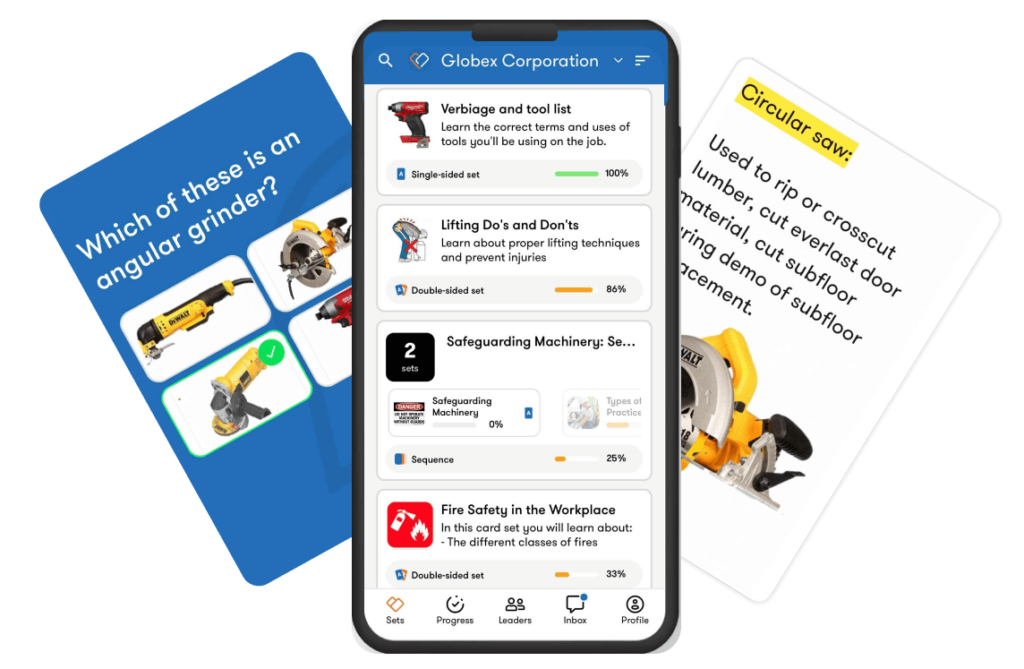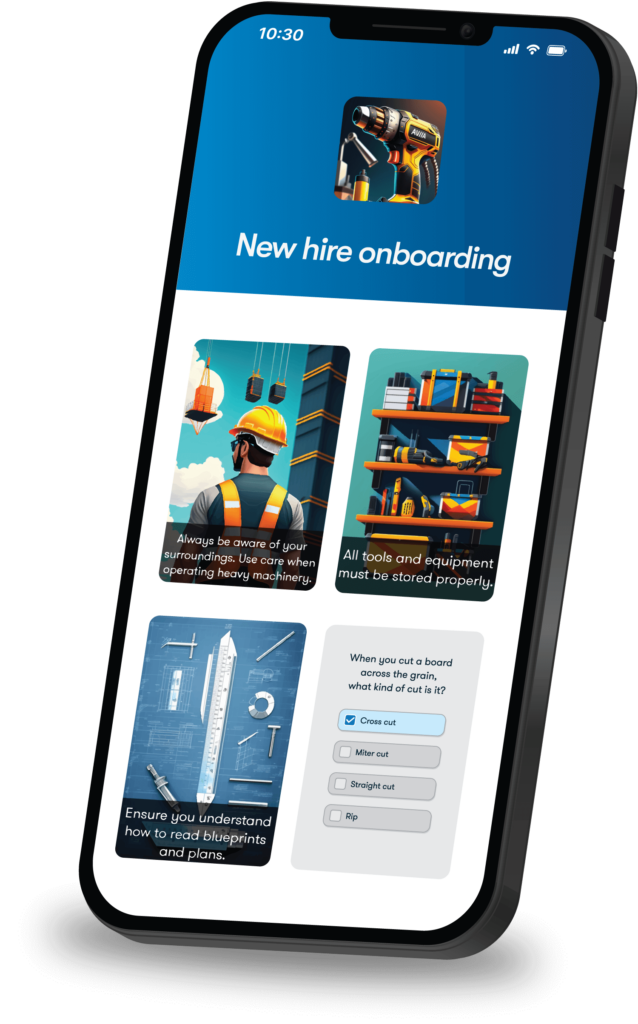In a world where industries are constantly evolving, the frontlines of work extend beyond office walls. The true heroes are often the deskless workers, and there is a need to bridge the gap between specialized knowledge and the practical demands of the job. This is where technical training comes in.
Technical training helps your employees develop the skills and knowledge required to thrive in our technology-driven world. It’s a tailored approach that delivers job-specific training to employees, boosting their productivity and quality of work.
In our exploration of technical training, we’ll define its core principles, examine the various types available, and uncover the steps to create an effective training program. We’ll also discuss common pitfalls to avoid and highlight the role of technology, including mobile training platforms, in bringing it all together.
What is technical training?
Technical training provides employees with the skills to work with specific technologies, applications, products, or services. These programs are a form of competency based training, and they ensure employees can perform their technical tasks effectively, while staying updated on the latest industry trends and best practices. Unlike other corporate training, technical training is more complex and specialized.
For instance, technical training programs include teaching software developers how to create and troubleshoot software applications, or specializing technicians on how to repair complex machinery. These programs are vital for improving job performance, job satisfaction, and company success.
Oftentimes learning and development teams are responsible for creating technical training programs. In some cases, more senior employees or production managers develop technical training materials as they are the ones with direct experience on how to correctly carry out the job. Since this training can be delivered in several different ways, it’s important to decide which format best fits the skill and learner.
Types of technical training
Formal education
Traditional technical training is offered by institutions such as universities, colleges, and vocational schools. These programs lead to degrees, diplomas, or certificates. For example, a computer science degree from a university can lead to a technical career.
Online learning
These tech-based training methods provide flexibility, allowing you to access materials anytime, anywhere. For example, you can complete online web development certification from home, enhancing your technical skills. Additionally, online learning can be used at work. Many companies choose to incorporate mobile learning to keep information in their employee’s hands.
On-the-job training
This type of training happens in the workplace, making it a convenient and cost-effective choice. It can include online learning, classroom-style sessions, job rotation, coaching, apprenticeships, or temporary promotions. In healthcare, on-the-job training might involve shadowing more experienced providers.
Additionally, training programs may cover soft skills like effective communication, problem-solving, interpersonal abilities, civility, ethics, and creativity. These skills complement technical expertise and improve overall job performance.
7 tips to help develop a successful technical training program
1. Assess training needs
Conduct a thorough needs analysis of your organization’s training requirements. Pinpoint areas where skills are lacking, job-specific needs, and opportunities for improvement. To get a comprehensive view, seek input from employees, supervisors, and HR professionals.
2. Define training goals
Begin by identifying objectives for your training program. Pinpoint the particular skills and knowledge your employees need to excel in their roles. Ensure that these objectives align with both departmental and business goals and follow the SMART (Specific, Measurable, Attainable, Relevant, Time-bound) criteria.
3. Collaborate across departments
Work with other departments to ensure your training program covers all relevant topics. Collaboration ensures that employees receive a well-rounded education and are equipped to handle various challenges.
4. Choose appropriate training methods
Select training methods that work with your organization’s needs and budget. You may choose traditional training, a mobile training platform, on-the-job training, or a combination of the three. Incorporating technology helps enhance training programs. Online courses, interactive modules, and access to mobile learning can make training more accessible and effective.
5. Develop engaging training content
Technical training often covers complex topics such as software use and intricate processes. To enhance effectiveness, use interactive methods that keep learners engaged and foster interaction between training and employees.
6. Ensure employees have time for your training
Put your training program into action by delivering it to your employees in a way that makes sense for both the business and the learners. Follow your training plan, always keep the learning objectives top of mind, and be flexible when things aren’t going exactly as planned.
7. Continuously evaluate your training program
After implementing the training, measure its effectiveness by regularly assessing the program. Use methods like 1:1 discussions, post-training surveys, and quizzes to gather data on measurable outcomes. Evaluation helps determine the impact of the training on employee skills and the company’s return on investment.
What to avoid when implementing technical learning
Now that you know what to focus on, let’s dive into what not to do. Implementing technical learning programs can be challenging. To ensure your training efforts succeed, it’s crucial to avoid common mistakes. Let’s highlight some of the most important ones:
Lacking clear goals and objectives
We’ve already touched on this, but it’s getting another mention because of its importance. First and foremost, you must identify your employees’ training needs. Before starting a technical training program, take the time to determine the exact skills and knowledge your employees need for success. Don’t start the process of technical training without being crystal clear on needs, goals, and objectives.
Taking on too much learning
Avoid overwhelming participants with excessive information. Instead, focus on keeping learners engaged and motivated, encouraging them to return for more and remain actively involved in the training program.
Unclear plan
Maintain organization and preparedness in your technical training programs. A well-organized learning experience minimizes glitches and ensures effective training delivery.
Not following up
Without training evaluations, there’s no way to know if the learning was effective. Regularly measure and evaluate your technical learning programs. Ongoing assessment ensures your programs align with your organization’s objectives and continually improve.
By sidestepping these common mistakes, you can effectively implement technical training programs and provide employees with what they need to excel in their roles.
How a mobile training platform brings it all together
In today’s dynamic work environment, where deskless workers play a pivotal role across various industries, the demand for accessible and effective technical training has reached new heights. Mobile training platforms have emerged as a transformative solution that not only addresses the challenges of modern work but also consolidates the essential components of successful technical training.
These platforms offer unmatched accessibility, allowing employees to access training materials at their convenience, even when offline, regardless of location or time constraints. Such flexibility aligns seamlessly with the mobile nature of deskless workers, allowing for quick module reviews and deep dives into complex processes whenever necessary.

Customization is another hallmark of mobile training platforms. You can mold training content to your unique needs. By embedding training goals, objectives, and the skills employees need, these platforms ensure that the training program remains perfectly aligned with the organization’s needs. This eliminates ineffective generic training.
Mobile platforms are engineered for interactive learning, essential for keeping employees engaged and promoting meaningful interaction between the training content and the learners. Features like interactive quizzes, video content, and gamified elements enhance the learning experience. Intricate technical subjects become more digestible and improve learner outcomes.
These platforms also offer real-time evaluation and tracking capabilities, enabling employers to assess training effectiveness continuously. Monitoring progress, identifying areas for improvement, and making necessary adjustments in real-time are all facilitated. When something isn’t working, you can update training materials in real time at no cost.
The convenience and engaging user experience of a well-designed mobile training platform empower employees to take control of their learning journey. Its ease of use and the freedom to access training content on mobile devices significantly enhance participation and the overall training experience.
Make training accessible anywhere with a powerful mobile learning app

FAQs
What are examples of technical training?
Technical training can take on many forms. Some of those include:
- Formal education
- Online certification
- On-the-job training
- Technical skills training
- Compliance training
What are the 3 types of training?
The three types of training are instructor lead, eLearning or mobile training platform, and on-the-job training.
What are technical training needs?
Technical training needs are the skills and knowledge employees need to do their jobs well. Some of these are software training, technical skills training, compliance training, and product training.
What is technical skill development training?
Technical skill development training is close to the definition of technical training. It concentrates on delivering employees the precise skills and knowledge required to excel at work. It is pivotal in equipping employees working in industries demanding specialized expertise.
The power of technical training for deskless workers
In the modern work environment where many employees are on the move, accessible and effective technical training is essential. Mobile training platforms have emerged as a valuable solution to bridge the gap between specialized knowledge and the practical challenges of today’s work environments. These platforms make technical training more accessible, engaging, and tailored to individual needs.
Key takeaways
- Technical training provides the skills and knowledge needed to perform specific jobs.
- Technical training comes in various forms, such as formal education, online courses, and on-the-job training.
- Incorporating technology in training through mobile training platforms improves accessibility and effectiveness.
- Recognize training needs, avoid information overload, stay organized, and measure training effectiveness to sidestep common pitfalls.
Build technical training your teams can access anywhere with TalentCards



